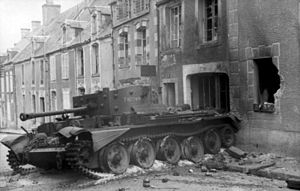Battle of Villers-Bocage
| Battle of Villers-Bocage | |||||||
|---|---|---|---|---|---|---|---|
| Part of Operation Perch | |||||||
 A British Cromwell observation post tank on Villers-Bocage's main street; one of more than a dozen vehicles destroyed by Michael Wittmann. This tank was commanded by Captain Paddy Victory of the 5th Royal Horse Artillery. |
|||||||
|
|||||||
| Belligerents | |||||||
|
|
|
||||||
| Commanders and leaders | |||||||
|
|
|
||||||
| Strength | |||||||
| One Brigade group c. 60 tanks |
2 ad-hoc battle groups Elements of 1 heavy tank battalion 31–41 tanks |
||||||
| Casualties and losses | |||||||
| ~217 casualties 23–27 tanks |
Unknown total casualties 8–15 tanks |
||||||
| Several civilians | |||||||
The Battle of Villers-Bocage took place during the Second World War on 13 June 1944, one week after the Normandy Landings by the Western Allies that began the conquest of German-occupied France. The battle was the result of a British attempt to improve their position, by exploiting a gap in the German defences west of the city of Caen. After one day of fighting in and around the small town of Villers-Bocage and a second day defending a position outside the town, the British force retired.
The Allies and the Germans regarded control of Caen as vital to the Normandy battle. In the days following the D-Day landings on 6 June, the Germans rapidly established strong defences in front of the city. On 9 June, a two-pronged British attempt to surround and capture Caen was defeated. On the right of the British Second Army, the 1st US Infantry Division had forced back the German 352nd Infantry Division and opened a gap in the German front line. Seizing the opportunity to bypass the German Panzer-Lehr Division blocking the direct route south in the area of Tilly-sur-Seulles, a mixed force of tanks, infantry and artillery, based on the 22nd Armoured Brigade of the 7th Armoured Division, advanced through the gap in a flanking manoeuvre towards Villers-Bocage. British commanders hoped that the appearance of a strong force in their rear would force the Panzer-Lehr Division to withdraw or be surrounded.
Under the command of Brigadier William "Loony" Hinde, the 22nd Armoured Brigade group reached Villers-Bocage without serious incident on the morning of 13 June. The leading elements advanced eastwards from the town on the Caen road to Point 213, where they were ambushed by Tiger I tanks of the 101st SS Heavy Panzer Battalion. In fewer than 15 minutes numerous tanks, anti-tank guns and transport vehicles were destroyed, many by SS-Obersturmführer Michael Wittmann. The Germans then attacked the town and were repulsed, losing several Tigers and Panzer IV. After six hours, Hinde ordered a withdrawal to a more defensible position on a knoll west of Villers-Bocage. The next day the Germans attacked the defensive "Brigade Box" in the Battle of the Island. The British inflicted a costly repulse on the Germans and then retired from the . The Battle for Caen continued east of Villers-Bocage, which was captured, in ruins, on 4 August after two raids by the strategic bombers of the Royal Air Force.
...
Wikipedia
